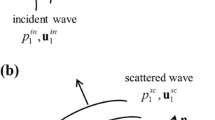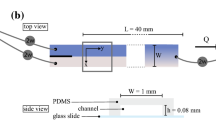Abstract
In order to measure the axial flowing velocity of carbon particle suspension with particle diameter of tens of micrometers, the photoacoustic Doppler (PAD) frequency shift is calculated based on a series of individual A scans using an autocorrelation method. A 532 nm pulsed laser with repetition rate of 20 Hz is used as a pumping source to generate photoacoustic signal. The photoacoustic signals are detected using a focused piezoelectric (PZT) ultrasound transducer with central frequency of 5 MHz. The suspension of carbon particles is driven by a syringe pump. The complex photoacoustic signal is calculated by the Hilbert transformation from time-domain photoacoustic signal, and then it is autocorrelated to calculate the Doppler frequency shift. The photoacoustic Doppler frequency shift is calculated by averaging the autocorrelation results of some individual A scans. The advantage of the autocorrelation method is that the time delay in autocorrelation can be defined by user, and the requirement of high pulse repetition rate is avoided. The feasibility of the proposed autocorrelation method is preliminarily demonstrated by quantifying the motion of a carbon particle suspension with flow velocity from 5 mm/s to 60 mm/s. The experimental results show that there is an approximately linear relation between the autocorrelation result and the setting velocity.
Similar content being viewed by others
References
Y. Cai, N. Arsad, M. Li and Y. Wang, Optoelectronics Letters 9, 233 (2013).
H. F. Zhang, K. Maslov and L. V. Wang, Physical Review Letters 99, 184501 (2007).
J. Yao and L. V. Wang, Journal of Biomedical Optics 15, 021304 (2010).
J. Yao, K. I. Maslov, Y. Shi, L. A. Taber and L. V. Wang, Optics Letters 35, 1419 (2010).
J. Brunker and P. Beard, Proc. SPIE 7564, 756426 (2010).
C. Kasai, IEEE Transactions on Ultrasonics, Ferroelectrics, and Frequency Control 33, 458 (1986).
D. Piao, L. L. Otis, N. K. Dutta and Q. Zhu, Applied Optics 41, 6118 (2002).
Y. Zhao, Z. Chen, C. Saxer, Q. Shen, S. Xiang, J. F. de Boer and J. S. Nelson, Optics Letters 25, 114 (2000).
Y. Zhao, Z. Chen, C. Saxer, Q. Shen, S. Xiang, J. F. de Boer and J. S. Nelson, Optics Letters 25, 1358 (2000).
D. Piao and Q. Zhu, Applied Optics 42, 5158 (2003).
Y. Xu and L. V. Wang, Medical Physics 28, 1519 (2002).
Author information
Authors and Affiliations
Corresponding author
Additional information
This work has been supported by the Joint Funds of the National Natural Science Foundation of China (No.U1204612), and Natural Science Foundation of He’nan Educational Committee (No.13A416180).
Rights and permissions
About this article
Cite this article
Lu, T. Photoacoustic Doppler flowmetry of carbon particles flow using an autocorrelation method. Optoelectron. Lett. 10, 467–469 (2014). https://doi.org/10.1007/s11801-014-4102-y
Received:
Published:
Issue Date:
DOI: https://doi.org/10.1007/s11801-014-4102-y




